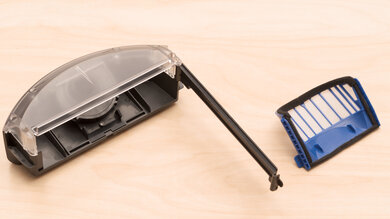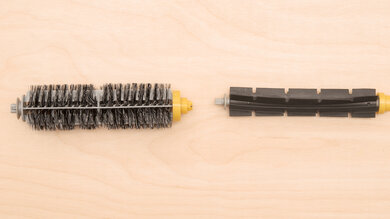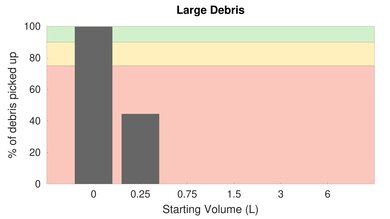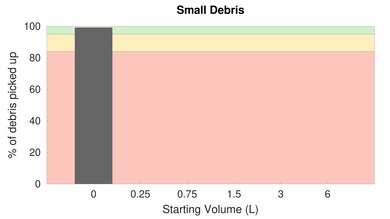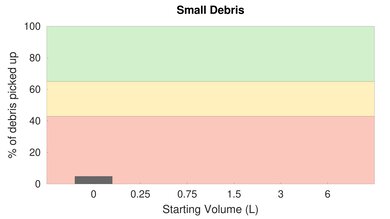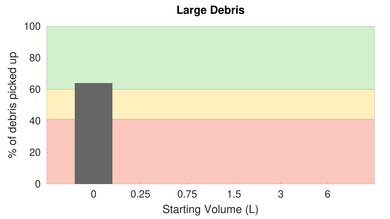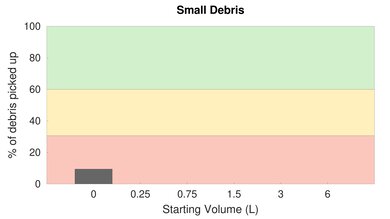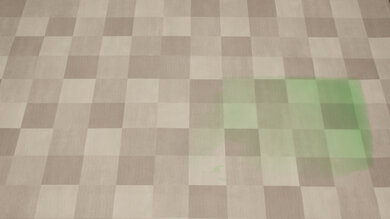The iRobot Roomba 675 is an entry-level model within iRobot's extensive lineup of robot vacuums and is one of its most budget-friendly models to offer Wi-Fi connectivity. Unlike some other entry-level models, it doesn't come with a remote control. However, it's fully compatible with Amazon Alexa and Google Home devices, enabling you to make inputs using voice commands. It also has a surface detection system that lets it raise its brushroll on carpeting. However, it falls short of pricier models in terms of other automation features, with no support for room mapping, and has a somewhat weak suction motor that struggles with deep-cleaning jobs on carpeting.
Our Verdict
The iRobot Roomba 675 is decent for use on bare floors. It cleans most debris on bare floors well but struggles a bit with hair. It doesn't have a precise cleaning pattern, but it still can clean an entire room. Unfortunately, it has several parts that need regular servicing, so it's not the easiest to maintain. It also incurs fairly high recurring costs.
-
Great build quality.
-
Decent performance on bare floors.
-
Outstanding battery life.
-
Struggles with hair.
-
Not easy to maintain.
-
High recurring costs.
The iRobot Roomba 675 is disappointing on low-pile carpet, as it struggles with finer debris on this surface type. It also has quite a few parts that need periodic cleaning and incurs high recurring costs. On the upside, it's good at maneuvering itself and has an automatic surface-type adjustment feature.
-
Great build quality.
-
Outstanding battery life.
-
Poor performance on carpets.
-
Struggles with hair.
-
Not easy to maintain.
-
High recurring costs.
The iRobot Roomba 675 is a poor choice for use on high-pile carpet. Its surface detection system enables it to climb onto carpeting, but it still has trouble clearing away solid debris. It also incurs high recurring costs and has many parts that need periodic cleaning.
-
Great build quality.
-
Outstanding battery life.
-
Poor performance on carpets.
-
Struggles with hair.
-
Not easy to maintain.
-
High recurring costs.
The iRobot Roomba 675 is a poor fit for cleaning up pet hair. It doesn't suck up much hair from any surface type, and the vacuum itself isn't easy to maintain, though it does have a removable brushroll, which makes it easier to clear tangled hair. It also incurs high recurring costs.
-
Great build quality.
-
Outstanding battery life.
-
Struggles with hair.
-
Not easy to maintain.
-
High recurring costs.
The iRobot Roomba 675 isn't designed to use on stairs.
The iRobot Roomba 675 isn't designed to use in cars.
The iRobot Roomba 675 is a robot vacuum and isn't designed for workshop cleaning.
- 7.1 Bare Floor
- 5.8 Low-Pile Carpet
- 5.8 High-Pile Carpet
- 4.3 Pets
- 5.8 Stairs
- 4.8 Cars
- 4.0 Workshop
- Updated Dec 01, 2022: We've updated the text in the review to account for the new tests and scoring methodology in Vacuum Test Bench 0.5 and Vacuum Test Bench 0.6.
- Updated Nov 23, 2022: We've updated the 'Differences Between Variants' section of this review to include the iRobot Roomba 671 model.
- Updated Sep 23, 2022: We've lowered the score for the 'Cracks' section to maintain consistency with similarly-performing robot vacuums.
- Updated Sep 01, 2022: Converted to Test Bench 0.6.
- Updated Aug 30, 2022: Converted to Test Bench 0.5.
- Updated May 26, 2021: Corrected input errors in 'Quality Of Life Features' and 'Automation (Robot Vacuum)' sections.
- Updated Feb 22, 2021: Updated review for accuracy and clarity.
- Updated Jul 10, 2020: We've updated this vacuum's dimensions, and updated the recurring cost of some parts.
- Updated Jul 06, 2020: Review published.
Check Price
Differences Between Sizes And Variants
We tested the iRobot Roomba 675, which is only available in black. It's also sold as iRobot Roomba 671 in Europe. There's a variant of this vacuum, the Roomba 605, which doesn't have app support. Besides automation, we expect our results to be valid for the other variants, which are listed below.
| U.S. Model Name | App Automation | Notes |
|---|---|---|
| Roomba 605 | No | |
| Roomba 671 | Yes | European designation for the iRobot Roomba 675 |
| Roomba 675 | Yes |
If you come across a different variant of this vacuum, let us know in the comments, and we'll update the review.
Compared To Other Robot Vacuums
The iRobot Roomba 675 is an entry-level robot vacuum. It falls noticeably short in performance compared to similarly-priced and positioned alternatives like the eufy RoboVac 30C. The lack of remote control is also a bit of a nuisance if you were looking for a basic robot vacuum that you can use without an internet connection. Conversely, if you're looking for something cheap that you can control with a smart home speaker, it's a pretty solid option.
If you're looking for something else, see our recommendations for the best robot vacuums, the best robot vacuums for pet hair, and the best vacuums.
The iRobot Roomba 675 is more versatile than the bObsweep Bob Pro. The iRobot is better built, is easier to maintain, and charges much faster. It does a better job of picking up pet hair, but it struggles more than the bObsweep when it comes to clearing fine debris on carpeted surfaces. The bObsweep also has a longer continuous battery life, a larger dirt compartment, and comes with a remote controller, so you don't need Wi-Fi to use it.
The iRobot Roomba 675 is better than the eufy RoboVac G30. The iRobot feels better built, incurs lower recurring costs, charges much faster while offering similar battery life, and delivers slightly better performance on bare floors and low-pile carpets. Conversely, the eufy comes with a set of physical boundary strips that keep it out of certain areas and clears a little more debris on high-pile carpets.
The iRobot Roomba 675 and the Shark ION Robot RV700 Series each have advantages, meaning one may suit you better than the other, depending on your needs. The iRobot feels better built, has less demanding maintenance requirements, incurs lower recurring costs, and does a better job of maneuvering itself. It also recharges much faster, though the Shark has a longer battery life. The Shark also comes with a set of physical boundary strips to keep it out of certain areas, has a larger dustbin, and delivers better overall performance on bare floors as well as low- and high-pile carpets.
The yeedi vac station is better than the iRobot Roomba 675. The yeedi delivers much better performance on carpeted floors, maneuvers itself far more effectively, and has a wider assortment of automation features, including its self-emptying function and support for virtual boundary markers. It also has a longer battery life than the iRobot, though the latter does charge a lot faster. The iRobot also incurs lower recurring costs and struggles slightly less with bulkier debris.
The iRobot Roomba i4 is better than the iRobot Roomba 675. The i4 delivers better cleaning performance on bare floors, low-pile carpet, and high-pile carpet. It also maneuvers more effectively thanks to its smart-pathing navigation system and has a far more advanced suite of automation features. Meanwhile, the 675 is slightly easier to pick up and carry to another room, incurs fewer recurring costs, and has a slightly longer runtime, though it takes longer to recharge.
The iRobot Roomba 694 is slightly better than the iRobot Roomba 675. The 694 has a larger dustbin and delivers superior performance on bare floors as well as high-pile carpets. Meanwhile, the 675 has a carrying handle that makes it easier to pick up and carry. The 675 also struggles less with sucking up larger material like sand from low-pile carpets.
The Wyze Robot Vacuum is better than the iRobot Roomba 675. The Wyze is easier to maintain, performs better on most surface types, does a better job of clearing away pet hair, and has a more advanced LIDAR mapping sensor, which results in superior maneuverability and a more robust suite of automation features, like support for no-go zones and scheduling for individual room cleaning sessions.
The iRobot Roomba i3 is a better-performing robot vacuum than the iRobot Roomba 675. The i3 delivers better performance on all surface types and uses smart pathing to maneuver itself more efficiently. It also has an automatic dirt disposal feature. Nevertheless, the 675 has a longer battery life and is more portable because it has a carrying handle.
The iRobot Roomba 675 is a better robot vacuum than the Coredy R550 (R500+). The iRobot is better built, easier to maintain, and has fewer recurring costs. Its battery performance is better, and it cleans bare floors and low-pile carpets more effectively. However, the Coredy does a better job on high-pile carpets and comes with a remote controller so that you can pilot the robot.
The iRobot Roomba 675 is more versatile than the eufy RoboVac 15C. The iRobot has an allergen-trapping HEPA filter, is better built, is easier to maintain, incurs fewer recurring costs, and has a longer battery life while taking less time to charge. It also performs slightly better on bare floors and maneuvers more efficiently. Meanwhile, the eufy offers slightly better performance on low- and high-pile carpets and comes with a remote control.
The yeedi K650 is a better vacuum than the iRobot Roomba 675. The yeedi delivers better performance across all surface types, has a much bigger dirt compartment, and better automation features. On the other hand, the iRobot is equipped with an allergen-trapping HEPA filter and is easier to maintain.
The iRobot Roomba 614 is a better vacuum than the iRobot Roomba 675. The 614 has a better performance on bare floors and carpets, a bigger dirt compartment, and a slightly longer battery life. On the other hand, the 675 is equipped with an allergen-trapping HEPA filter and has a companion app that allows you to schedule cleaning times.
The Shark AI Robot is better than the iRobot Roomba 675. The Shark has a more advanced navigation system that allows for room mapping and smart-pathing. It also incurs lower costs of ownership than the iRobot, has a larger dustbin, lasts longer on a charge, and does a better job of maneuvering itself. On the other hand, the iRobot feels slightly sturdier, recharges a lot faster, and does a better job of dealing with debris in cracks, like grout lines on a tile floor.
The Neato Botvac D7 is a better overall performing robot vacuum than the iRobot Roomba 675. The Neato does a better job of picking up all kinds of debris on all surface types, including pet hair. It's also easier to maintain, it has a larger dirt compartment, its battery has a slightly shorter charge time, and you can also control it using the companion app as a remote control. However, the iRobot has slightly fewer recurring costs, and it's lighter.
The iRobot Roomba 675 and the ILIFE A4s are robot vacuums with different strengths and, depending on your usage, you may prefer one over the other. The iRobot is better built, easier to maintain, and has a better battery performance. It can also pick up more small and large debris from bare floors. However, the ILIFE does a better job on carpet. Its dirt compartment is larger, and it has more automation features.
The iRobot Roomba 675 and the ONSON GOOVI F007 Robot Vacuum are robot vacuums with different strengths. The iRobot is better built with less demanding maintenance needs and fewer recurring costs. It's more maneuverable, has a better battery performance, and clears bare floors more thoroughly. However, the ONSON vacuum does a better job on low- and high-pile carpets. Its dirt compartment is also larger.
The iRobot Roomba 675 is more versatile than the Eureka Groove. The iRobot is better built, struggles much less with bulky material, and maneuvers more effectively. Conversely, the Eureka cleans more fine material on high-pile carpets, is a little more compact, and doesn't require an internet connection to function.
The Roborock E4 is a better overall vacuum than the iRobot Roomba 675. The Roborock performs significantly better on all surface types, has a larger dirt compartment, and has longer maximum battery life. It also has a broader range of automation options, like the remote piloting feature in its companion app and efficient smart pathing. Meanwhile, the Roomba is lighter and charges faster.
The iRobot Roomba 675 is a bit better overall than the eufy RoboVac 11S. It's easier to maintain, there are fewer recurring costs, it's better built, and it has better battery life. However, the eufy has better performance, especially on carpet, and it's a better choice if you have pets.
The iRobot Roomba E5 is a bit better overall than the iRobot Roomba 675. The two robot vacuums are very similar and have the same features. The E5 performs much better on both low-pile and high-pile carpet and also has a bigger dirt compartment. However, the 675 is a bit better on bare floors, and its battery lasts longer.
The Roborock S5 is much better than the iRobot Roomba 675. The Roborock performs much better on bare floors and carpets. It also has a bigger dirt compartment and has more automation features. On the other hand, the iRobot has a better battery since it takes much less time to recharge.
The Samsung POWERbot R7040 is better than the iRobot Roomba 675. It cleans a bit better on bare floors, and its performance on low-pile carpets is significantly better. The Samsung vacuum also has fewer recurring costs and is easier to maintain. The iRobot has a better battery life and has a side brush that helps clean debris in hard-to-reach areas.
The Roborock S4 is much better than the iRobot Roomba 675. The Roborock has much better performance on bare floors and low-pile carpets, but it can't clean on high-pile carpets, while the iRobot can clean some hair on high-pile carpets. The Roborock also has better automation features and a bigger dirt compartment. The battery on the iRobot takes less time to charge.
The iRobot Roomba 675 is better than the eufy RoboVac 30C. The iRobot has a better battery life, build quality, and better performance on bare floors and carpets. The eufy has two side brushes, while the iRobot has one, but they need to be replaced every three to six months.
Test Results
This vacuum has great build quality. It's made of hard plastic with a glossy finish on top and matte finish on the bumper. The dirt compartment, which has a built-in exhaust, has a foggy plastic cover on top that you can see through. Unfortunately, it's fragile and feels like it could break if dropped. Like most robot vacuums, there's no assembly required for the vacuum itself, and you only need to assemble the charging dock. There are three buttons on the top to initiate different commands, like cleaning, spot clean, or return to the dock, and there are battery indicator lights above the buttons. This vacuum also has a carrying handle, and there are built-in speakers to notify you of the vacuum's status, like when it starts or finishes a cleaning session.
The robot vacuum is a bit difficult to maintain, as there are a lot of parts that need maintenance.
- Dirt compartment: There's a button on top to release it. It needs emptying after each use, and you can't wash it with water. Emptying it can be a bit of a hassle, as debris can spill out of the large opening at the top of the dustbin.
- Brushrolls: This vacuum has two brushrolls: the bristle brush and the beater brush. They need cleaning about once a week, and if you have pets that shed, you should clean them twice a week. The bristle brush is exceptionally hard to clean, with longer strands of hair getting wrapped around its bearings and trapped deep within the bristles.
- Filter: You can remove the filter after emptying the dirt compartment, and you clean it by tapping it over a garbage can. Like the brushrolls, you should clean it once a week or twice a week if you have pets.
- Side brush: You should clean the side brush once a month, but you need a screwdriver to remove it. Thankfully, it's pretty easy to pull away any tangled hair.
- Wheels: You should clean the wheels about once every two weeks, and they're easy to take out. You can see if there's debris stuck in the wheels by spinning them by hand while they're still in the vacuum.
- Sensors: You should clean the sensors on the vacuum once a month with a dry cloth.
This vacuum has a few parts that need regular replacing and incurs fairly high recurring costs.
- AeroVac filter: You should replace the AeroVac filter every six to 12 months.
- Side brush: The manufacturer doesn't specify a replacement interval but says you should replace it when you notice signs of wear.
- Brushroll: You need to replace the brushrolls every six to 12 months.
- Wheel: You need to replace the front caster wheel every 12 months.
You can buy replacement parts on iRobot's online store. They sell a replenishment kit with three filters, the bristle brush, beater brush, a side brush, and a cleaning tool for the brushes. You can purchase any other part that breaks or needs replacement on their website.
This vacuum's debris capacity is pretty disappointing. Its dustbin is small, and there's no indicator to tell you if it's full, so you have to monitor it yourself. If you want a slightly bigger dirt compartment, check out the iRobot Roomba E5.
The vacuum has a practically unlimited range as long as it has battery life remaining and room left in its dirt compartment, but it can't go up stairs.
The vacuum has a carrying handle, making it very easy to carry around if you need to bring it to another floor.
This vacuum has incredible battery performance. While its max battery life of about two hours is less than alternatives like the bObsweep Bob Pro, it recharges in about two hours, which is great for a robot vacuum. It automatically changes its suction power based on the cleaning conditions, so it's worth noting that its runtime can vary pretty drastically depending on the floor types in your home. The battery indicator light on its top cover turns red when the battery is low, but it doesn't specify the battery percentage. The mobile app also notifies you when the battery is low.
This vacuum has a few extra features. It detects areas that are particularly dirty and increases its suction power as it cleans them. Unlike the Shark ION Robot RV700 Series, it can also detect what surface type it's on and automatically adjust its brushrolls' height, which helps it move from cleaning bare floors to high-pile carpets and vice versa. These features are automatic, and you can't change them manually.
This vacuum has a beater brush that crushes debris, so the bristle brush picks it up easier. There's also a side brush that pushes debris into the vacuum's path. If you want a robot vacuum with twin side brushes, look into the eufy RoboVac 30C or the ONSON GOOVI F007 Robot Vacuum.
Performance on bare floors is excellent. This vacuum doesn't have too many problems with both small and large debris. Its beater brush can crush large debris, making it easier for the main brushroll to clean, but some debris still gets pushed around by the side brush, and the vacuum doesn't pick it up. However, its ability to clear away heavier debris degrades significantly as its dustbin fills up.
This vacuum is bad at cleaning low-pile carpets. It picks up most large debris like sand but struggles with fine debris like baking soda. If you want a model with a better performance on low-pile carpets, look at the iRobot Roomba 960.
This vacuum's performance on high-pile carpets is mediocre. Unlike some robot models, it can climb onto and maneuver on high-pile carpets, but it doesn't clean them very well. It's somewhat effective in handling larger debris like sand but struggles with fine debris like baking soda. If you want a vacuum with a better performance on this surface type, try the Neato Botvac D7.
Like most robot vacuums, the iRobot Roomba 675 has low real-world suction force at its floorhead, as it's incapable of generating a tight seal against the contact surface.
This vacuum is pretty quiet. It's a little louder than other budget-friendly alternatives like the eufy RoboVac 25C, but you should still hear nearby conversation even with the vacuum running in the same room.
This robot vacuum is decent at maneuvering itself. It can move around on carpets since its automatic surface type adjustment feature allows it to change its height depending on what kind of floor it's cleaning. Its random-pathing navigation system results in a somewhat erratic cleaning pattern, but overall coverage is still quite thorough. It can go underneath couches and tables without any issues, and it cleans around and goes over wires. It can also go over rugs and clean them, but it could still drag them a bit.
This vacuum does a terrible job of sealing in fine allergens. Its AeroVac filter does almost nothing to prevent particles from being blown out of its exhaust.
This vacuum has a pretty hard time clearing away debris in cracks and crevices due to its low real-world suction force, though it still manages to clear away debris in shallow crevices like the grout lines on tile floors. It also makes less of a mess dislodging debris from cracks, compared to pricier models like the Roborock S6 MaxV.
This vacuum has little to no impact on dried-on stains. Unlike pricier models like the Roborock E4, there's no mopping system to help saturate dried-on messes.
The iRobot Roomba 675 has a reasonable range of physical automation features. It doesn't have a smart pathing feature, so it cleans rooms in a disorganized pattern. The buttons on top allow you to start a cleaning session, have the vacuum spot-clean an area, and send it back to its dock. The vacuum is compatible with Google Home and Alexa devices, meaning you can control it with voice commands. Unfortunately, it isn't compatible with a self-emptying base station and doesn't come with a remote control, so the only way to control it without an internet connection is with the buttons on top. If you're looking for something that comes with a remote control, look at the Eureka Groove.
The iRobot HOME companion app is good. It's fairly stripped down in terms of features, as it offers the same range of functionality as the physical control buttons but has an easy-to-use interface. With the app, you can have the vacuum start a cleaning session, spot-clean its immediate area, or stop a cleaning job and send it back to its dock. You can also use the app to check the battery status and create a cleaning schedule. Since the vacuum can't store a map of its coverage area, you can't send it to specific areas, set up virtual boundary markers, or schedule cleaning sessions for specific rooms.
Comments
iRobot Roomba 675: Main Discussion
Let us know why you want us to review the product here, or encourage others to vote for this product.
Update: We uploaded the latest brightness measurements and uniformity photos for the Accelerated Longevity Test.






